There are many types of wasps in Georgia. Some build paper-like multi-celled nests while others live underground. These wasps are not bound by territorial borders as they’re also found in neighboring states.
Here are the most common types of wasps found in Georgia.
Table of Contents
1. Eastern Yellowjacket
The Eastern Yellowjacket (Vespula maculifrons) is the most common wasp in Georgia.
This is a versatile wasp that lives both underground and in homes, garages, and other man-made structures. It’s considered a pest as it can build nests in residential areas.
These wasps are considered painful when they sting. Often confused with bees, they have the same black and yellow horizontal lines on their bodies but they are different in every aspect.
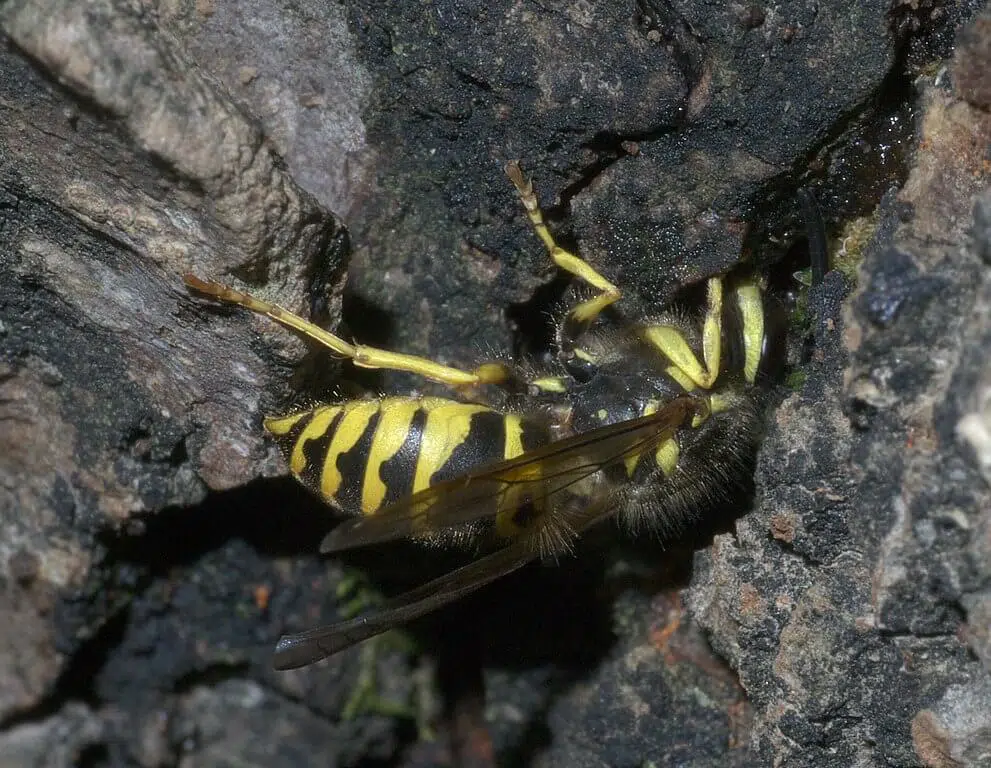
The Eastern Yellowjacket sting is dangerous and handling these wasps should be avoided. The species is known for its high aggression, especially when it comes to defending its offspring. They also sting when their hive is under threat.
2. Bald-faced Hornet
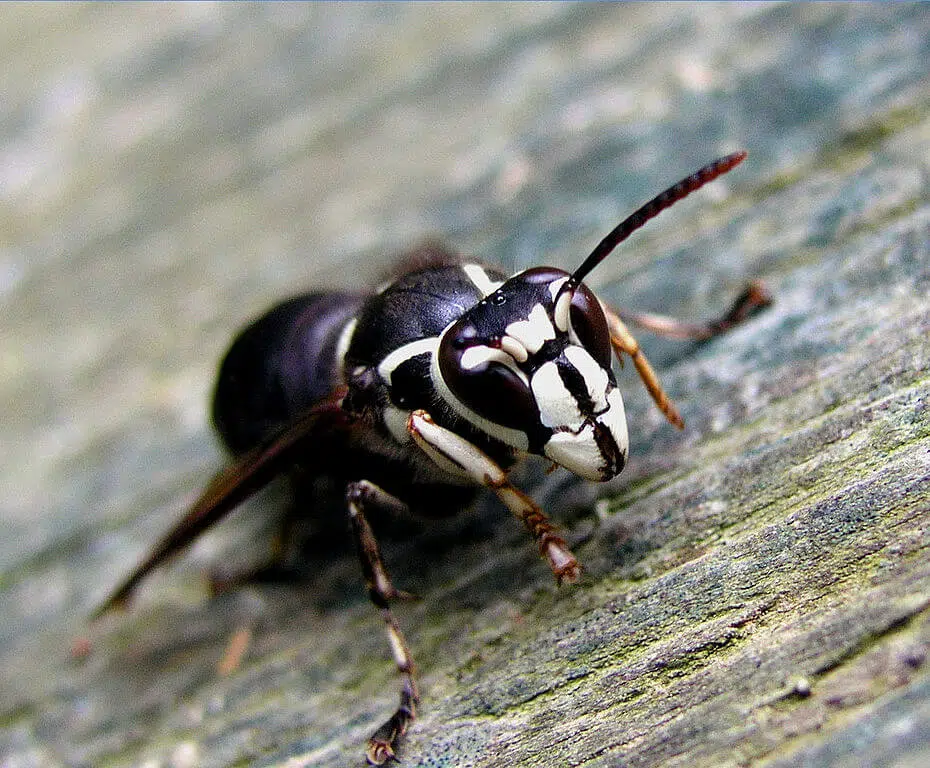
The Bald-faced Hornet (Dolichovespula maculata) is a type of Yellowjacket wasp. This means it inherits some of the traits of the Yellowjacket such as extreme aggressiveness as well as an innate ability to defend hives and offspring.
This black and white wasp is extremely common in Georgia and multiple other parts of the Southern US.
The Bald-faced Hornet is also one of the wasps that are dependent on a queen as they live socially in hives. The queen lays eggs and is aided by a group of female worker wasps.
The nest can be found almost everywhere around the state. It’s often found up in trees when the colony builds a hive outdoors. It can also be found in a barn corner next to the ceiling or even in homes, particularly in attics and other hard-to-reach areas.
3. Guinea Paper Wasp
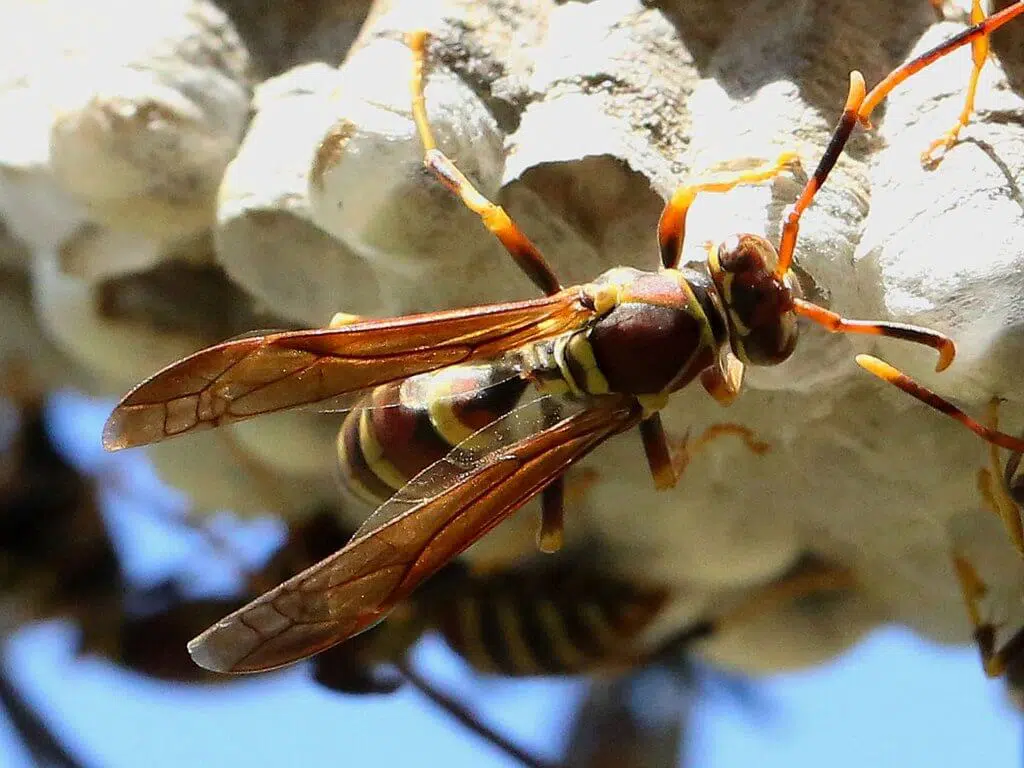
The Guinea Paper Wasp (Polistes exclamans) is common in Georgia. This species lives in colonies under very strict rules. There’s a queen to lead the colony but there are other principles that set hierarchy.
Age is one of the common factors that determine the role of wasps in this social hierarchy.
The Guinea Paper Wasp builds nests where hundreds or even thousands of wasps live.
This might be a common wasp but it also has a wide number of enemies. Birds are the most dangerous enemy of the Guinea Paper Wasp. They can bring the nest to the ground with a simple attack which also signals the end of the given colony as all wasps migrate towards new colonies in the case of a bird attack.
Ants are also problematic to the Guinea Wasp. However, this is a species that knows how to defend its nest and uses a few common tactics of meeting and attacking predators before they make it to the nest.
4. Metric Paper Wasp
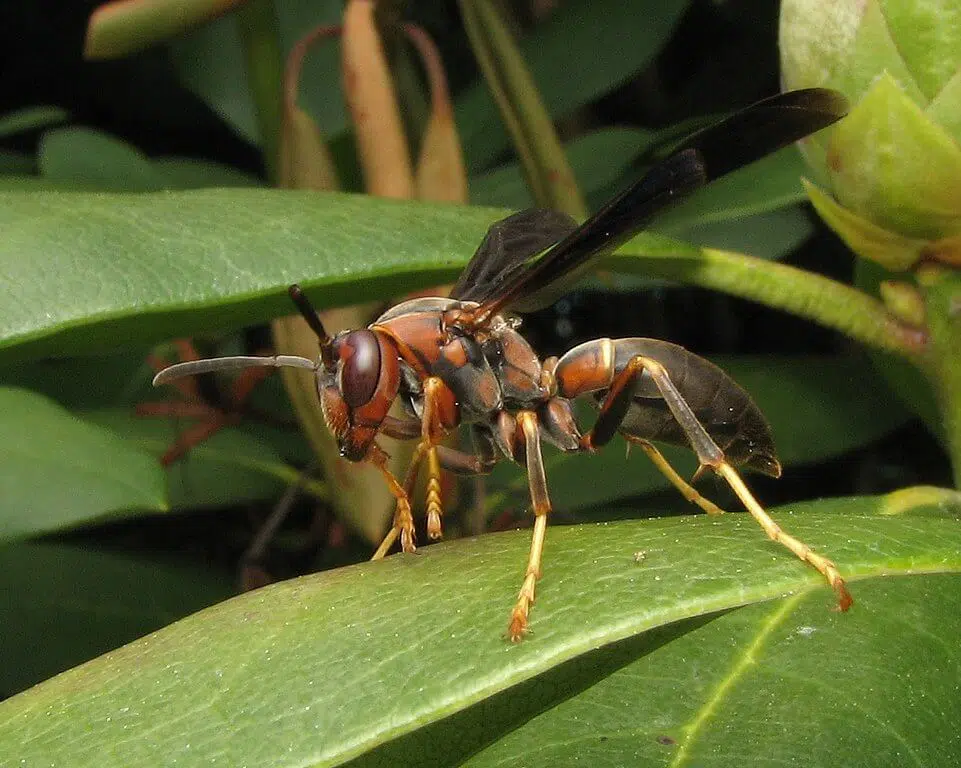
Part of the Polistes genus, the Metric Paper Wasp (Polistes metricus) is two-colored. The upper body is brown while the lower body is black.
These wasps are known for caring about their nests a lot, but they also share their nests with other species. They have been shown to reuse the same nest for multiple seasons.
The wasps have clear defensive tactics and a clear hierarchy. One of their nest-defending tactics refers to the way they fly, particularly by how they fly out of the nest.
There are 2 exit points for wasps flying the nest depending on where they go. For short flights, the wasps exit the nest from a lateral point horizontally. All wasps then plan on flying long distances exit and fly vertically first.
5. Eastern Cicada-killer Wasp
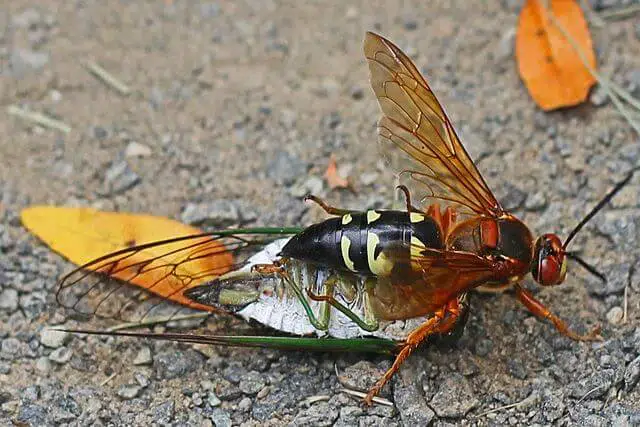
The Eastern Cicada-killer Wasp (Sphecius speciosus) is the most common digger wasp in Georgia. This yellow and black wasp has long transparent brown wings.
It’s known for digging and hunting cicadas. The wasp is among the natural predators that help keep the cicada population under control.
These wasps are also known for not being particularly aggressive. Female Eastern Cicada-killer Wasps can sting. But their sting isn’t as painful as the sting of other wasps. Males can’t sting but they appear aggressive in behavior.
Male Eastern Cicada-killer wasps are known for their curiosity, particularly towards perceived dangers surrounding the female wasp.
6. Southern Yellowjacket
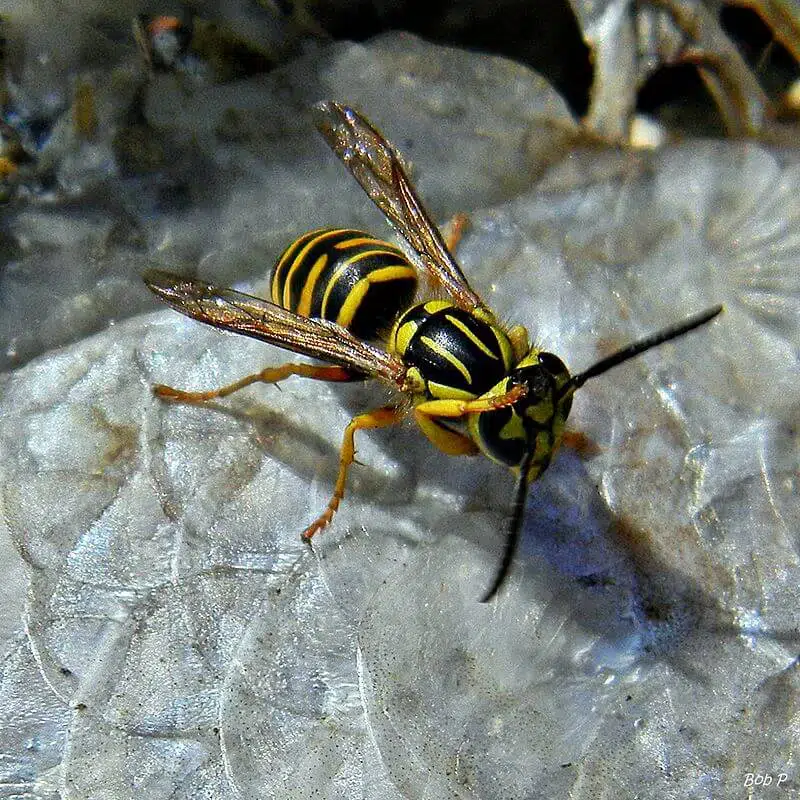
The Southern Yellowjacket (Vespula squamosa) is mostly found in Eastern US and down to parts of South America. This common wasp has a clear hierarchy with a dominant queen female leading the nest.
The wasp has black and white coloration and it uses pheromones both as a signal for danger and to attract mates.
Only the queen has the right to mate in the Southern Yellowjacket colony. This means the queens need to attract as many mates as possible. The queen releases pheromones to attract potential mates.
The spices feed on insects and animal carcasses.
It also shares the nest with some parasitic species. Neither of the species that share the nest produce any honey.
7. European Hornet
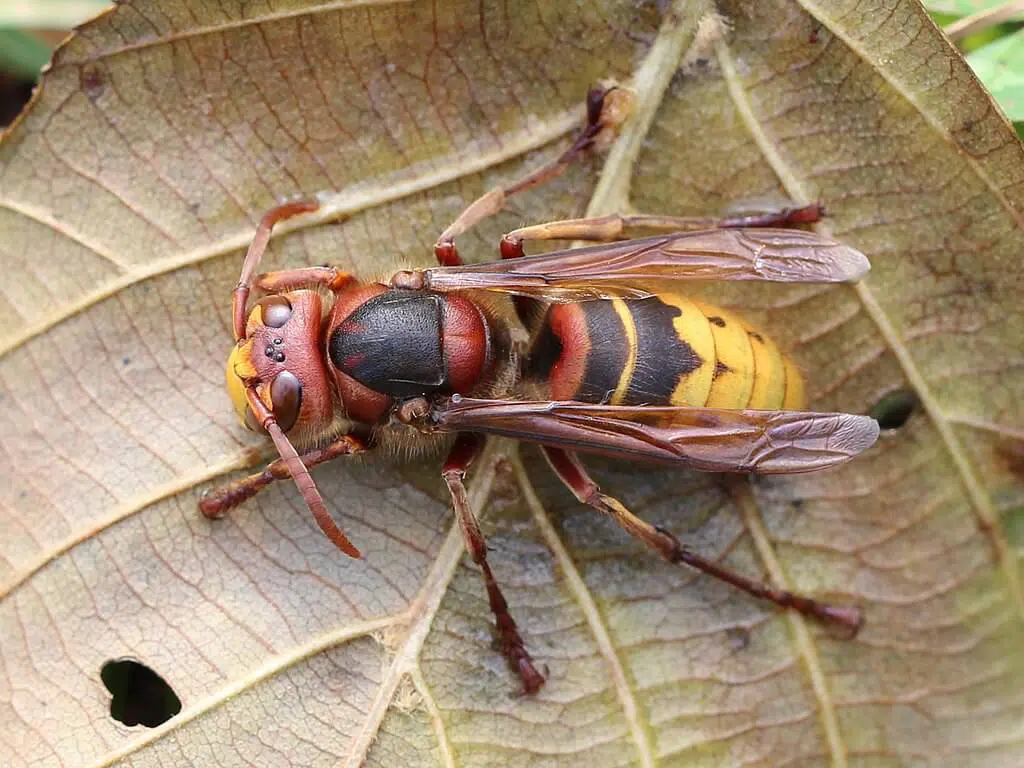
The European Hornet (Vespa crabro) has introduced to North America over 2 centuries ago. This hornet is known for building paper-like nests from plant fibers found in the area. The hornet is known not to be particularly aggressive. Its sting typically doesn’t require medical attention.
However, this is a species of wasp that is highly effective at reproduction and food gathering. It eats moths, flies, and even fruits for extra sugar.
The European Horney has also been known to steal food from other species. The wasp has been shown to steal prey caught up in spider webs. Preferred prey to steal includes dragonflies, moths, insects, and beetles.
8. Blue-winged Scoliid Wasp
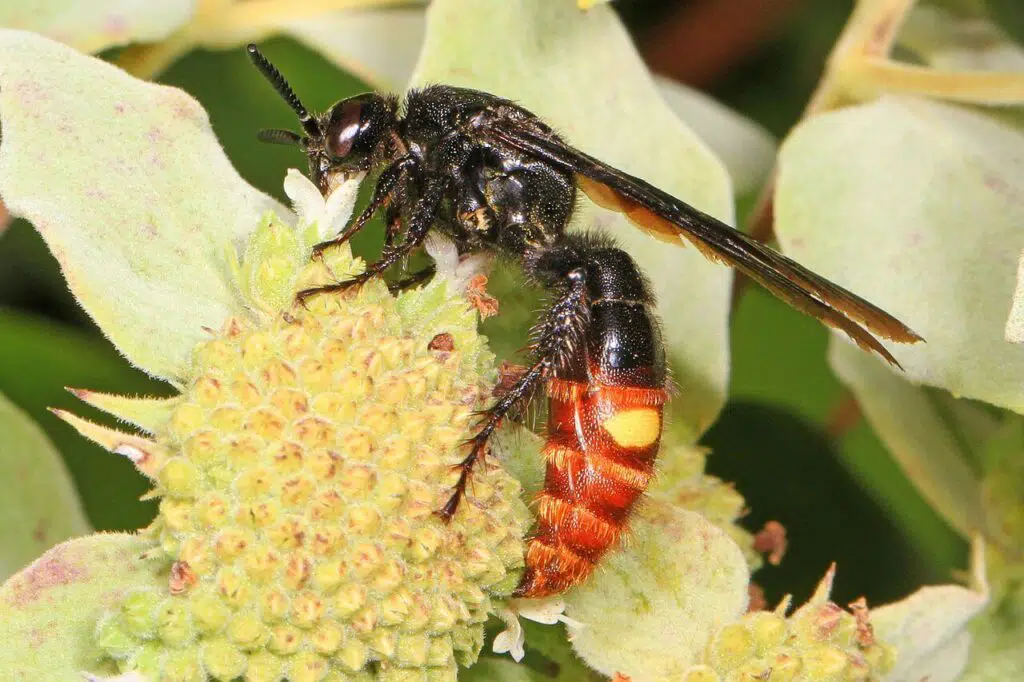
The Blue-winged Scoliid Wasp (Scolia dubia) is part of the Scolia genus. It can be identified by its red and black body as well as by its digging nature. It digs deep into soft grounds to look for the beetle.
This wasp also lays eggs deep into the ground. It’s known for digging deep.
Each of its eggs gets a separate chamber underground. A beetle is laid in this chamber and the eggs sit on top of it. The beetle serves as food for the larva.
Once the egg hatches and reaches maturity the wasp exists on the ground for the first time. It can grow to a maximum size of 1 inch.
9. Gold-marked Thread-waisted Wasp
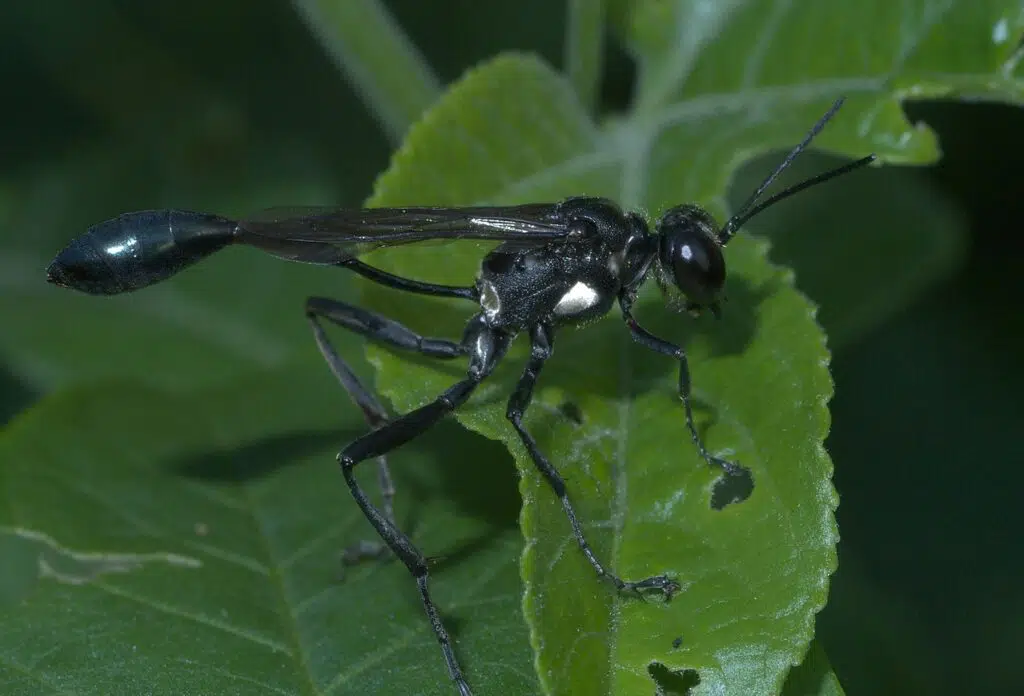
This black wasp (Eremnophila aureonotata) has blue markings on its body. During the day it’s found on flowers where it feeds on nectar. It’s often seen on Queen Anne’s Lace. However, this is a digging wasp known for its ability to dig burrows underground.
Only the female Gold-marked Thread-waisted Wasp digs underground. The female is typically looking for a safe place to lay eggs. These eggs are always matched by one caterpillar which is captured and paralyzed to be offered as food for the larva.
10. Four-toothed Mason Wasp
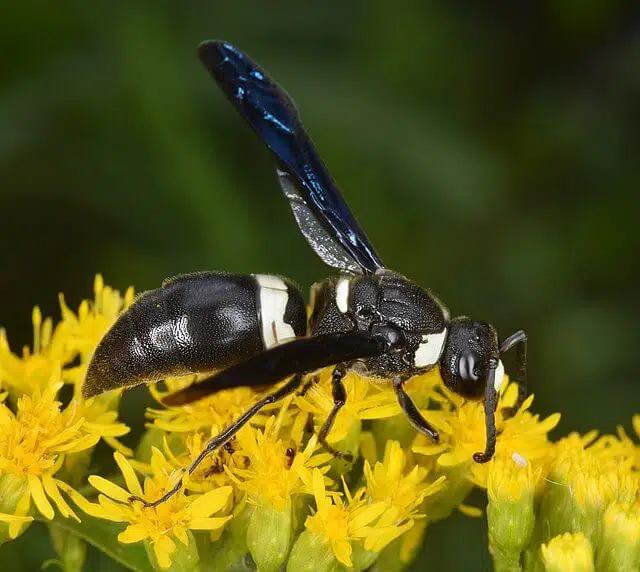
The Four-toothed Mason Wasp (Monobia quadridens) has similar habits to the Gold-marked Thread-waisted Wasp. Both are known for eating nectars and caterpillars.
These wasps are recognized by their almost all-black body. They are rather small compared to other wasps which means they easily find shelter in cavities. These wasps rarely build their nests as they live in cavities and nests of other species.
The Four-toothed Mason Wasp is considered dangerous to humans. Its sting is very painful. Furthermore, both the male and the female of the species are known to sting. The male’s sting is as painful as the female’s sting.
11. Wool Sower Gall Wasp
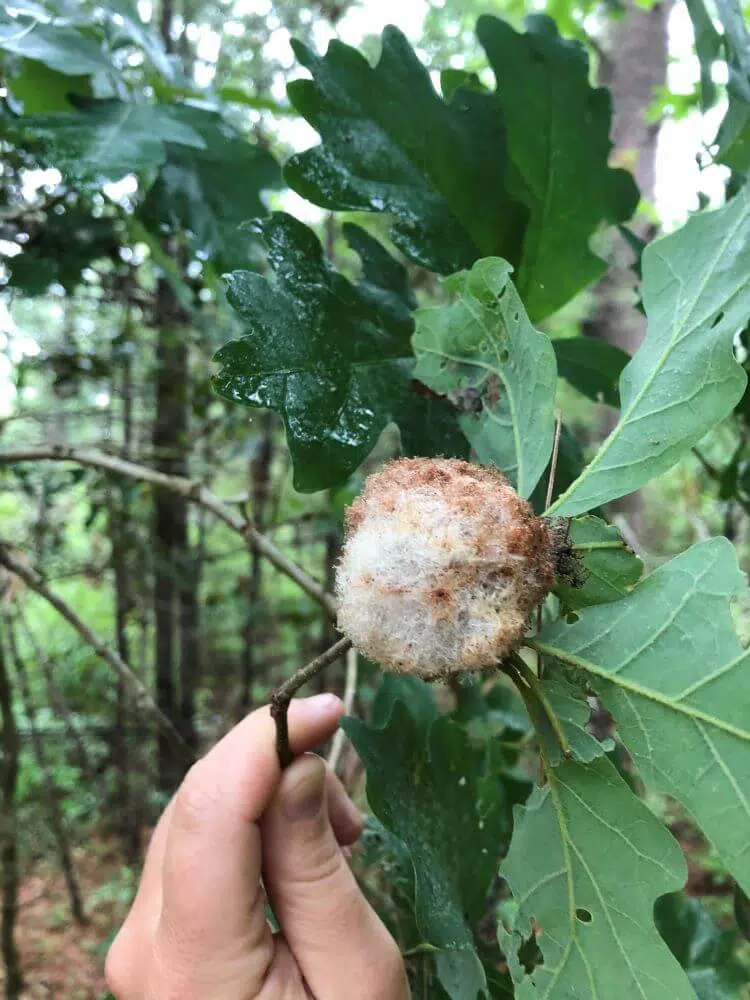
Galls are formed by wasps that lay eggs on trees’ living tissue. Most galls are formed on oaks in oak forests. The Wool Sower Gall Wasp lays galls on oaks.
The galls are normally white. But they can have pink spots on the outer edge. These galls are often overlooked by people as many mistake them for flowers or simply as part of the oak tree.
12. Fine-backed Red Paper Wasp
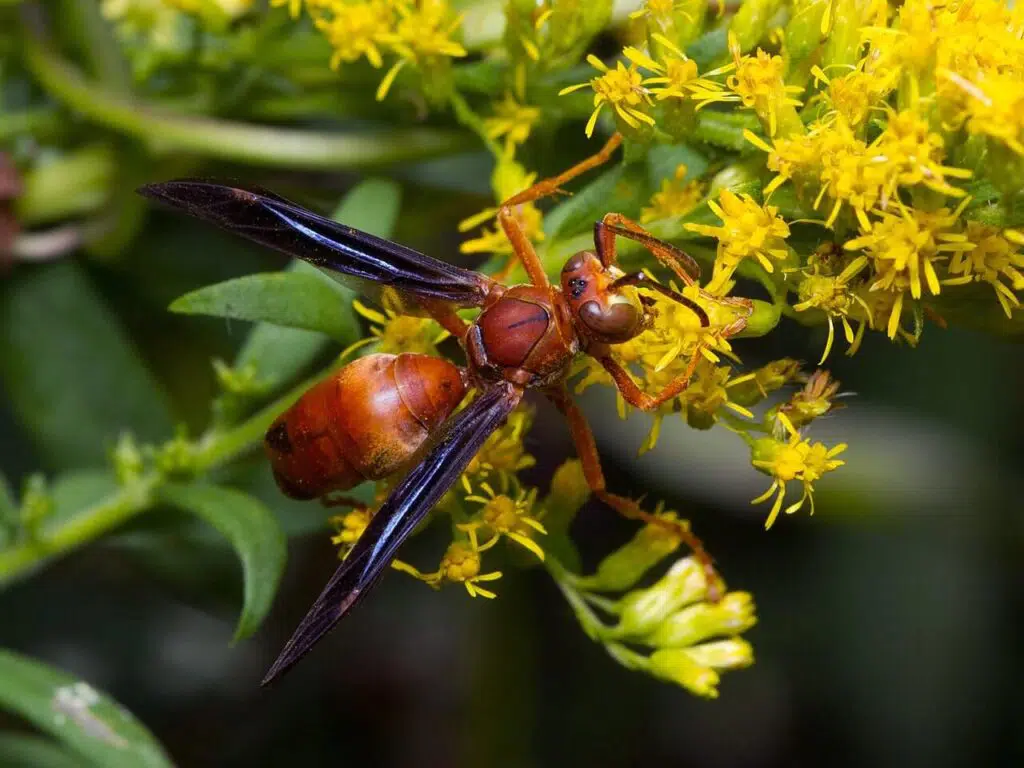
The wasp (Polistes carolina) is known for its red-brown color. It lives in special nests made from flower fibers. These nests can be found almost anywhere out in nature but also in man-made structures.
The wasps normally live in areas that are close to flowers as it likes to eat pure nectar. It also catches caterpillars which are offered as food for the larva.
There’s a clear hierarchy in Fine-backed Red Paper Wasp nests. The most dominant female or the queen is typically the fittest. This goes against the norm of having the largest female be dominant in a nest.
The fittest female wasp is known for getting out of hibernation first and then becoming the queen of a colony.
13. Dark Paper Wasp
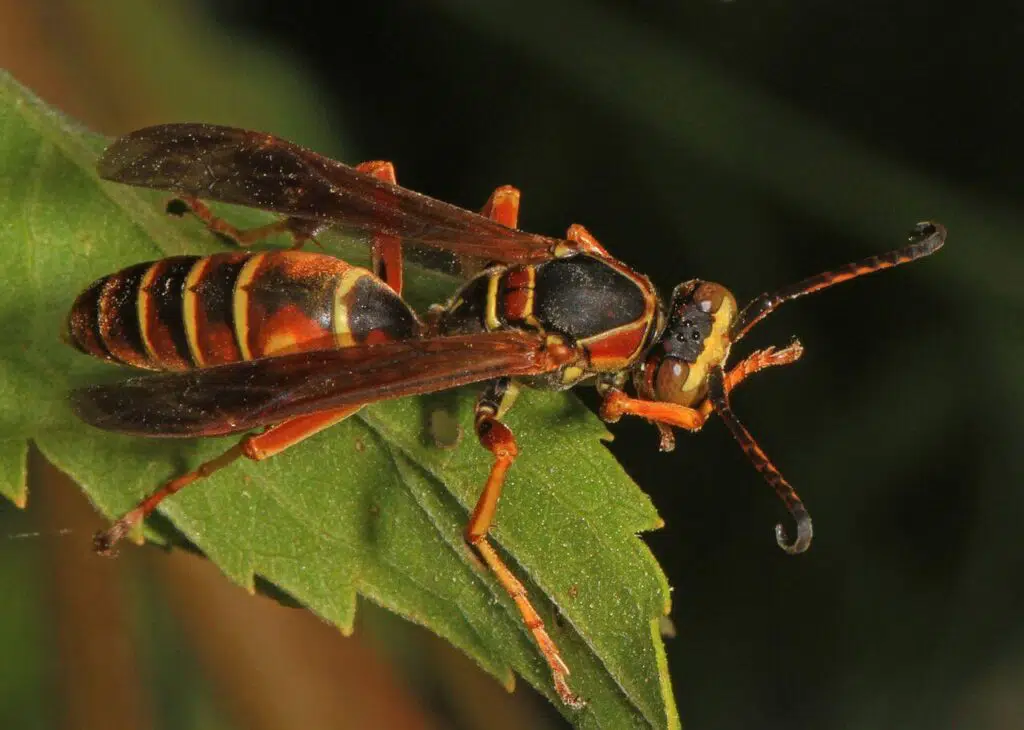
The Dark Paper Wasp (Polistes fuscatus) has brown-red, yellow, and black coloring. These wasps have a very large diet compared to those who only eat nectar.
Dark Paper Wasps eat meat, carbohydrates, and protein from plants, ants, flies, bees, and even from other wasps.
These wasps have lives centered around a dominant female leader. They have the habit of returning to the same location or nest for multiple seasons.
These wasps are very dominant and defensive of their nest. They can recognize wasps that aren’t part of the nest. Flying patterns gives away wasps that aren’t part of the same colony.
14. Ringed Paper Wasp
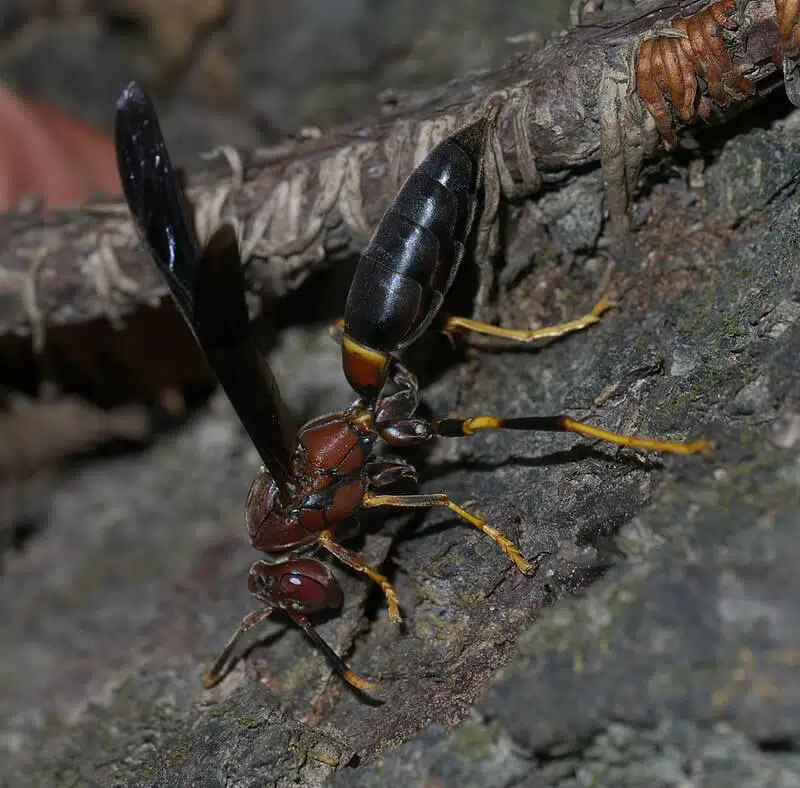
This wasp (Polistes annularis) is known for living next to water sources where it builds complex nests. The Ringed Paper Wasp is one of the most resilient species of wasps in Georgia. It can survive cold weather better than most other wasps, mainly by storing food such as honey in advance.
These wasps like to live in places with minimum sun penetration. It likes to eat insects. However, it also has a wide number of a predator. The ant-like wasp is hunted by large ants and birds. To escape bird attacks on its nest it prefers to build a shelter in remote areas that aren’t visible from a distance.
15. Noble Scoliid Wasp
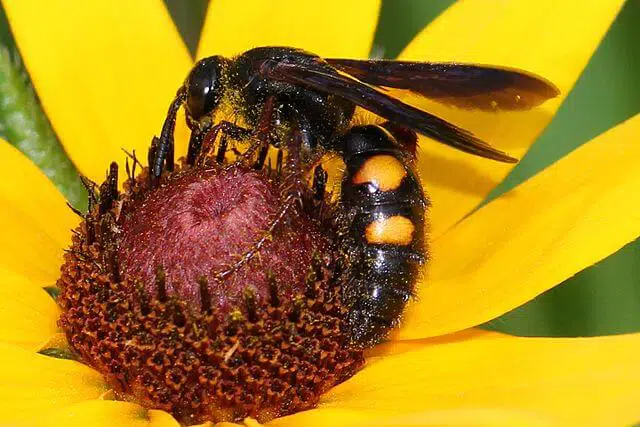
These wasps (Scolia nobilitata) are also common in Georgia. They are known as parasitic wasps that are highly known as opportunistic.
They don’t build shelters but they find shelters of other species to live in. When this happens, male wasps are often seen flying at low altitudes just above the ground seeking the perfect shelter to settle in.
While similar to the more common Yellowjacket wasp, the Noble Scoliid Wasp is known for having a darker body. Its black and yellow lines are a bit more faded. The horizontal yellow lines on its body are not as bright as the horizontal yellow lines on Yellowjacket and Yellowjacket subspecies.
16. Great Golden Digger Wasp
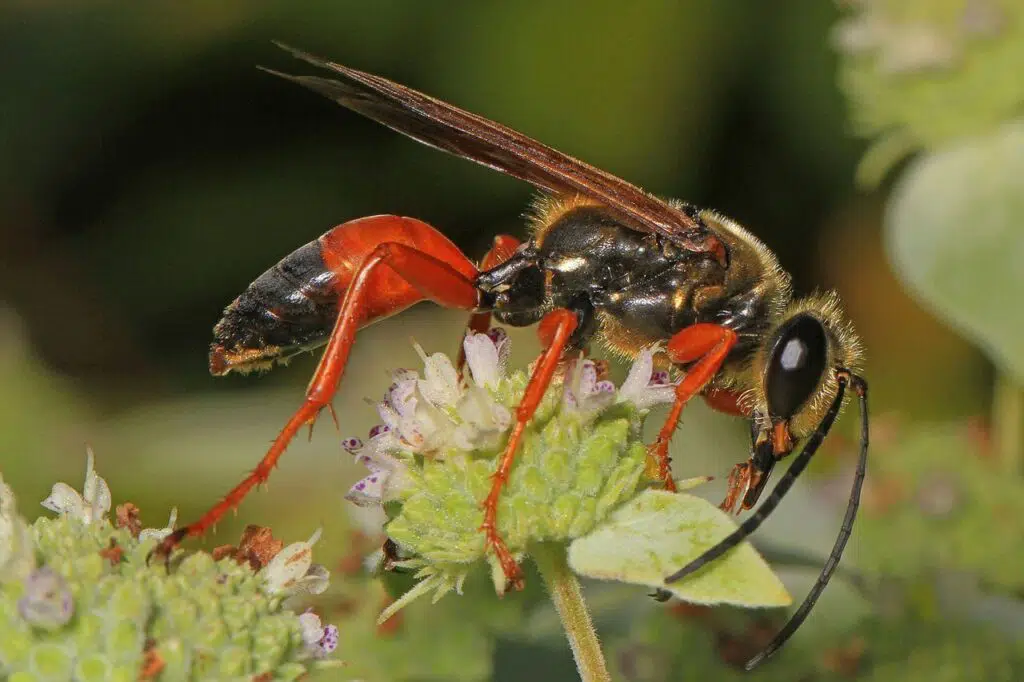
The Great Golden Digger Wasp (Sphex ichneumoneus) is one of the most harassed digger wasps. It’s constantly seen as prey by large birds such as robins.
The problem the Great Golden Digger Wasp has is that insects it eats are often seen as good food by birds. This is why birds often steal the insects the Great Golden Digger Wasp catches for its larva.
This wasp has to catch various insects to feed larva which is laid underground. The digger wasp uses its body to dig deep into the ground, typically for a few inches. It’s here that the wasp lays its eggs and it has to bring insects as food for the larva. Multiple attempts are often needed to successfully bring an insect to these tunnels when attacked by robins.
17. Feather-legged Scoliid Wasp
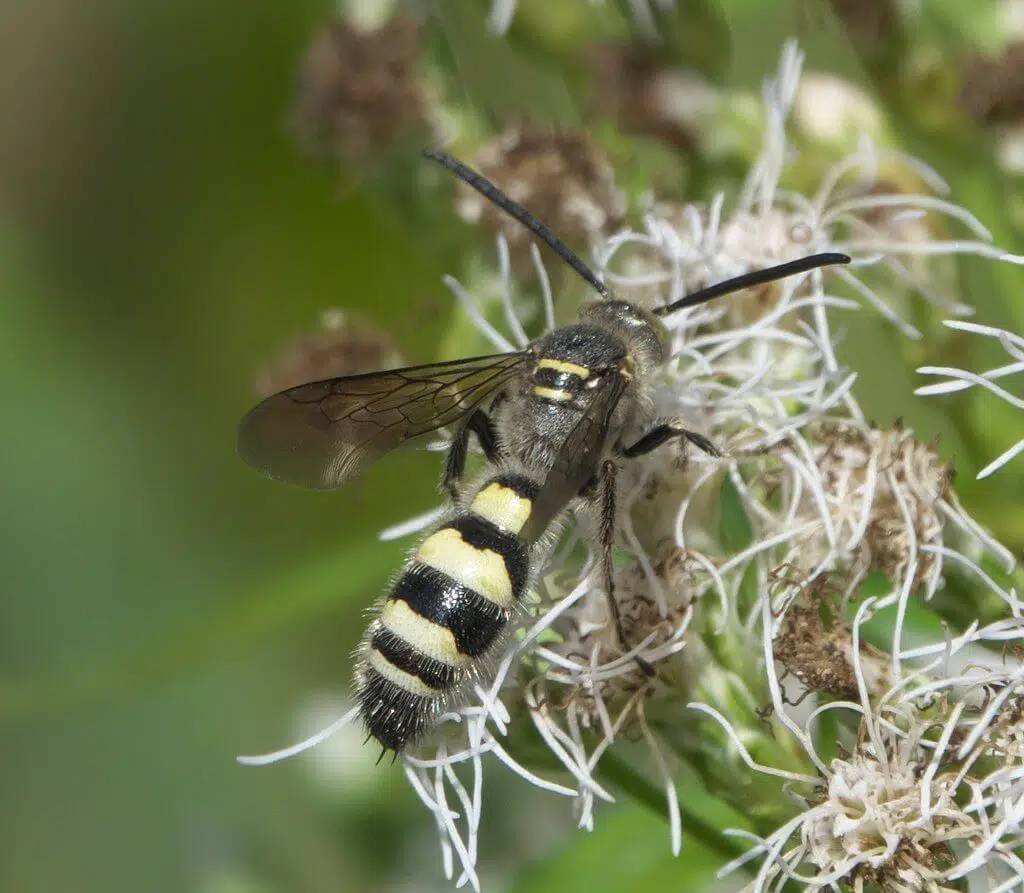
These wasp species (Dielis plumipes) are specific to Florida but it’s often reported in Georgia and other Southern states as well.
It’s a type of digger wasp with very specific prey. It likes to eat plant nectar but it also hunts beetle and beetle larva which is offered as food for its larva.
The female Feather-legged Scoliid Wasp is responsible for digging and laying eggs underground. The female wasp is among the most exemplary hunters of the beetle larva as a source of food to be taken underground.
This wasp gets its name after its hairy body. However, it also has other distinct characteristics such as flying in small formations just above the ground either to seek shelter or to seek out food.
18. Nearctic Blue Mud-dauber Wasp
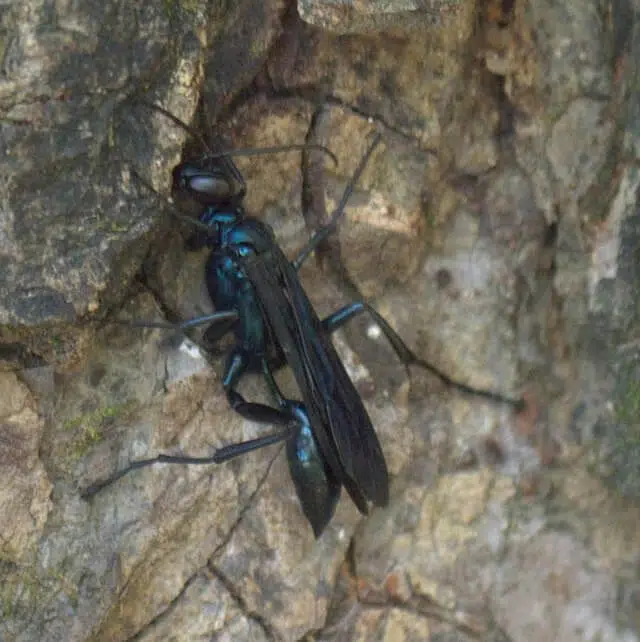
The wasp (Chalybion californicum) is instantly recognized by its vivid blue color. This electric blue color might make it stand out but it rarely stops the wasp from being a true predator. It’s one of the most feared predators of the Black Widow spider.
Otherwise, the wasp species is known for building nests. Female Nearctic Blue Mud-dauber Wasps build nests or repurpose nests from other species. They can sting as well.
Male wasps of the species have limited abilities. They can’t sting and they can’t build nests either.
With the ability to reuse nests of other species including bees, these wasps are also quick to reproduce. Multiple Nearctic Blue Mud-dauber Wasp species occur during a year.
19. Fraternal Potter Wasp
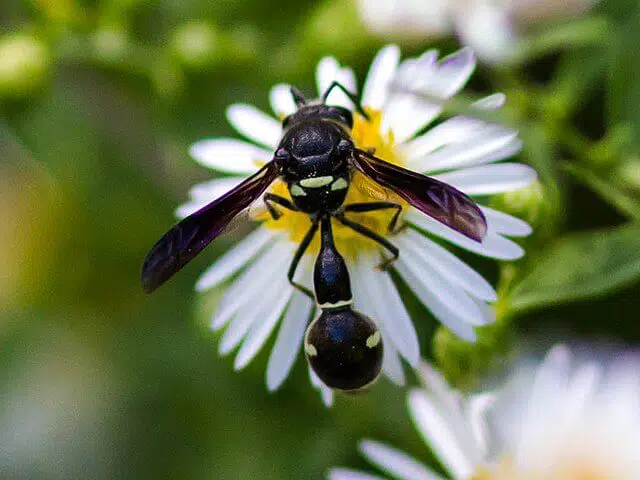
The Fraternal Potter Wasp (Eumenes fraternus) gets its name from its ability to build small clay pots as a sheltered space for its eggs. The wasp mixed mud and water to create miniature pots which are later used to lay an egg.
It also catches insects (typically a caterpillar) that is placed in the pot before its sealed. The living insect acts as food for the larva.
This wasp can also be identified easily as it has an unusually-thin body. Its thin first segment makes it look more like a regular insect than a wasp that can sting.
Still, the Fraternal Potter Wasp can sting and paralyze a large number of insects. It does it primarily for reproduction as it has to gather food for its larva.
20. Great Black Digger Wasp
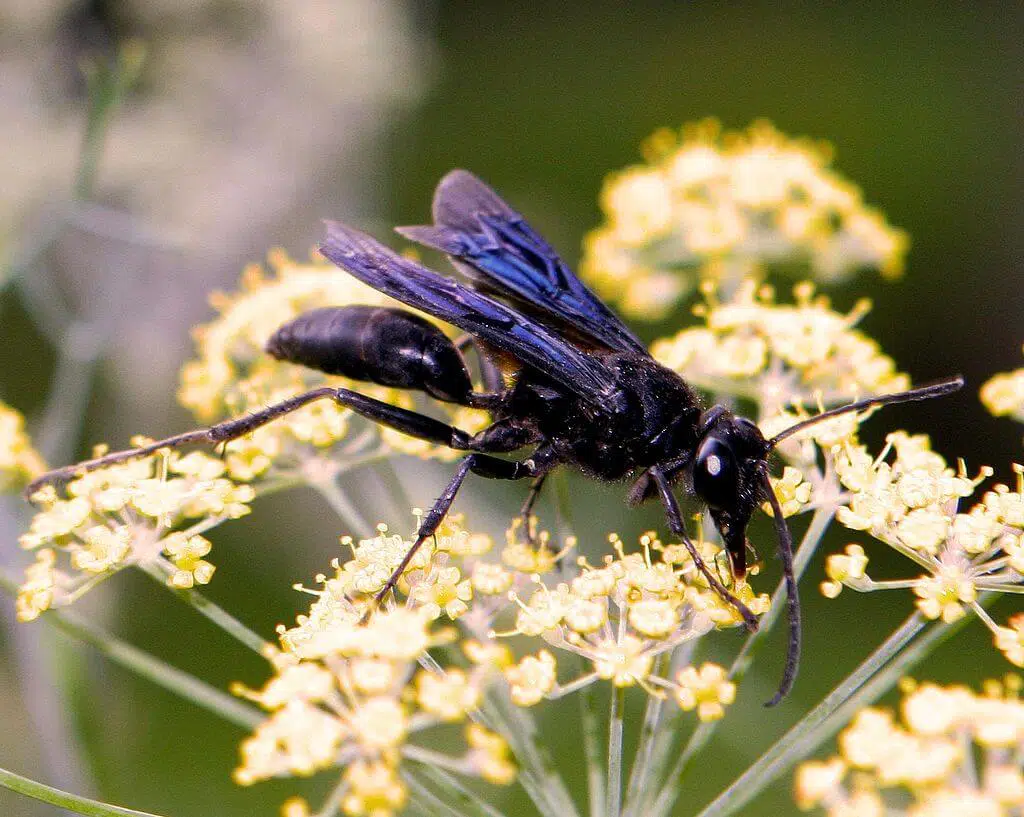
The Great Black Digger Wasp (Sphex pensylvanicus) is one of the first documented wasps of North America. Its role is well defined among natural pollinators, particularly as a milkweed pollinator.
These wasps are blue, black, and green. Females are slightly larger than males and they can sting. The sting of the Great Black Digger Wasp isn’t considered too painful, however.
This digger wasp is known for building underground tunnels for its larva. It stings insects to feed larva.
The Great Black Digger Wasp stings prey 3 times. One of these times it stings the insect behind the head and twice in the abdomen. This isn’t enough to kill it with venom. A paralyzed insect stung by the wasp can continue living up to a few weeks.
21. Yellow-legged Mud-dauber Wasp
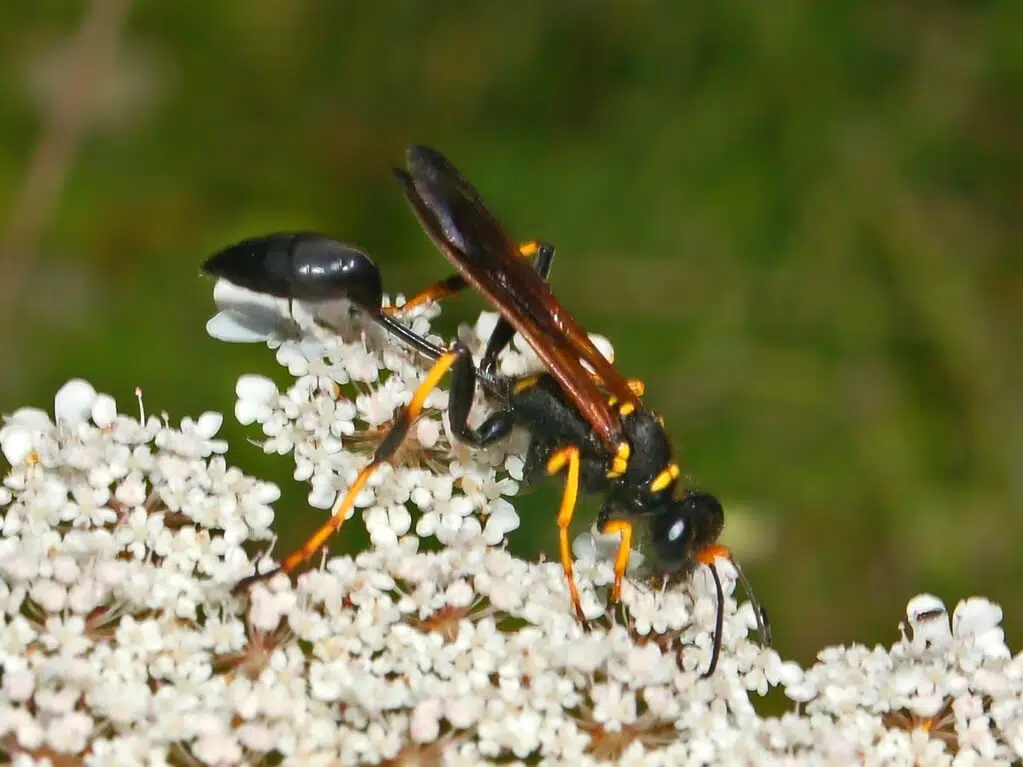
This parasitoid wasp species (Sceliphron caementarium) is known for its nest-building capacities using mud.
It can be recognized by its black abdomen and yellow-striped thorax. It grows to a maximum size of 28mm and it has the habit of building mud nests in nature and man-made buildings. It builds mud shelters for larva in these nests.
The wasp is known for hunting and killing various species of spiders. Live spiders are placed inside each mud cell it builds where it lays larva. Otherwise, adult Yellow-legged Mud-dauber rarely eats spiders. They prefer plant nectar.
They are rarely seen in the state as they like to live in solitude instead of building complex colonies.
22. Hunter’s Little Paper Wasp
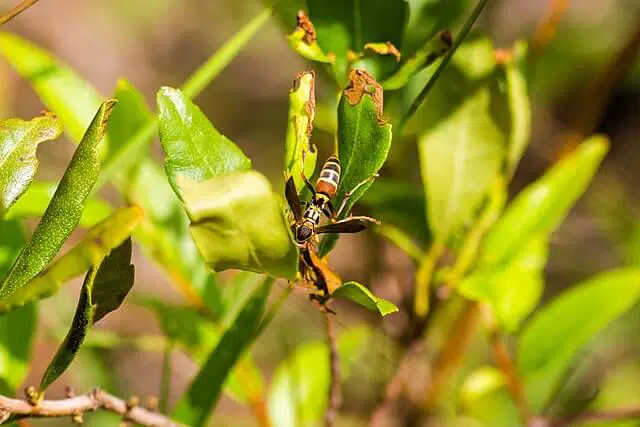
The Hunter’s Littler Paper Wasp (Polistes dorsalis) is a species that deliver a mildly painful sting. It has been associated with potential antimicrobial benefits.
These wasps are also some of the most common when it comes to the resemblance between the male and the female as both have V-shaped marks on their heads.
The wasp lives in colonies where the queen is the most important in the hierarchy. The larger the colony the more aggressive these wasps become to possible intruders.
While not as aggressive as other wasps, they have been associated with spreading out potentially dangerous fungus on cereal crops. Claviceps purpurea grows on some types of grass and cereal. The Hunter’s Little Paper Wasp often feeds on this fungus also helping to spread the fungal infection.
23. Common Thread-waisted Wasp
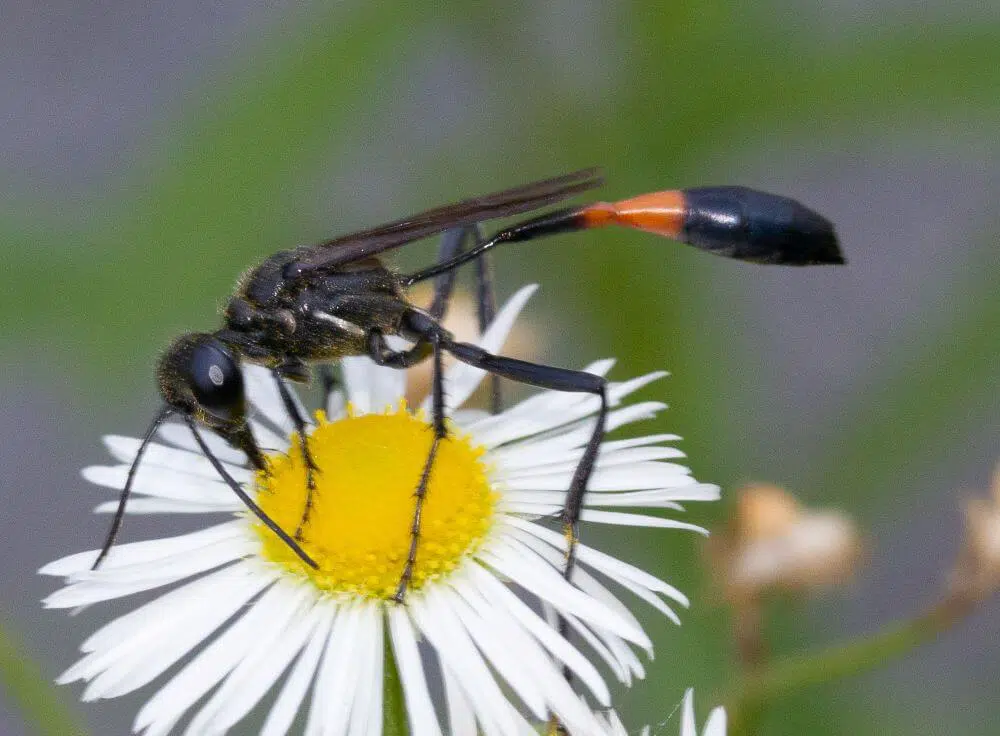
A digging capacity best describes this type of wasp species. It prefers habitats with soft grounds where it can dig multiple underground galleries to lay larva. The female is the responsible wasp with digging.
After digging a few inches in the ground the female lays an egg in each gallery. The female then makes a short flight around the tunnel to memorize landmarks and moves on to find caterpillars later fed to the larva that hatches in 2 days.
Hijacking other nests built by other Common Thread-waisted female wasps are also common.
24. Double-banded Scoliid Wasp
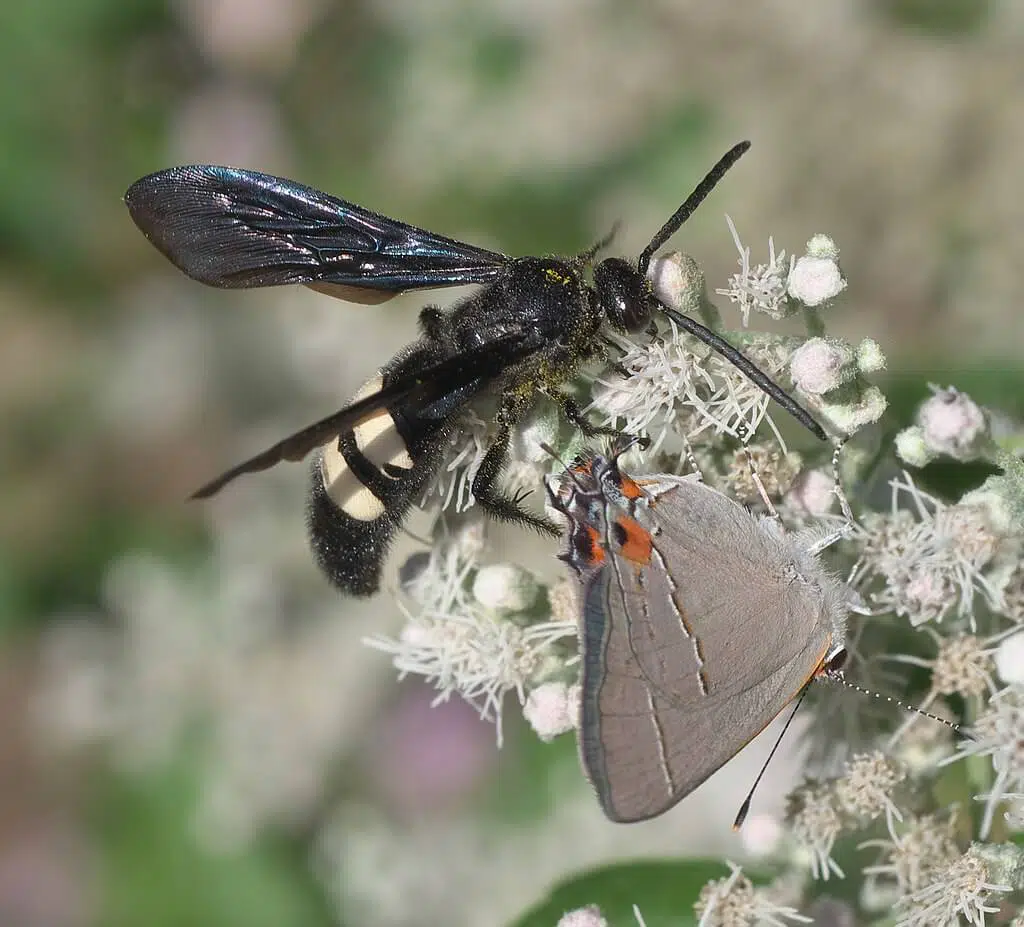
The Double-banded Scoliid Wasp (Scolia bicincta) has similar habits when it comes to larva. However, unlike the Common Thread-waisted Wsap, the Double-banded Scoliid Wasp looks for existing grub tunnels where it digs and stings the grub paralyzing it on the spot and laying an egg on top of it.
The egg is always abandoned as the female wasp never returns to the same location.
This species of wasps can be recognized by their black bodies with two horizontal white stripes on the abdomen. Its wings are distinctly colored as well. They can be either blue or purple.
25. Organ-pipe Mud-dauber Wasp
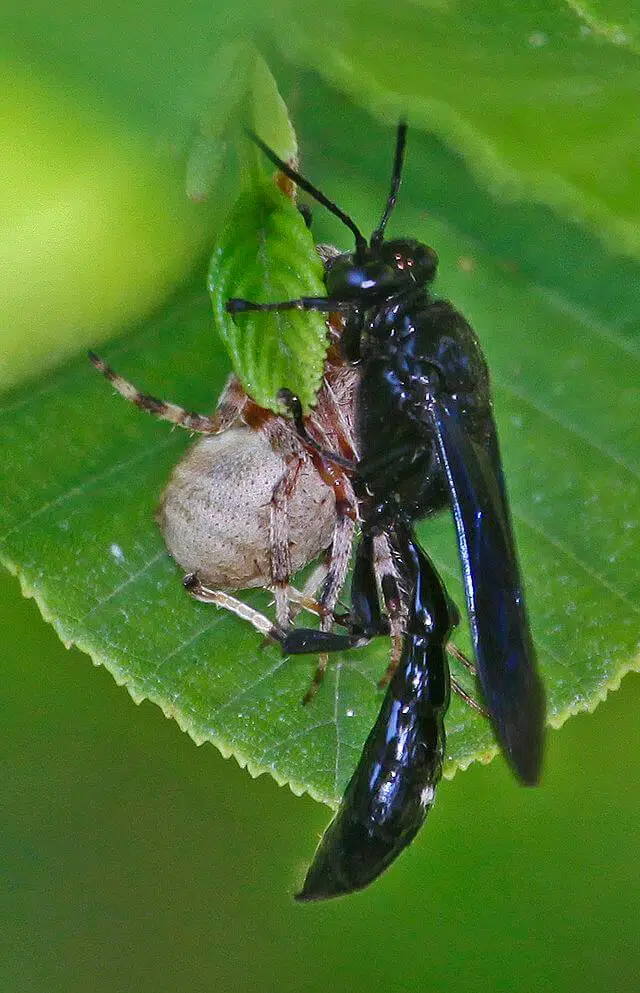
The Organ-pipe Mud-dauber Wasp (Trypoxylon politum) is known for its high reproductive rates which are often linked to an unusual way of protecting offspring.
The males of the species sit at the edge of the nest protecting offspring from potential intruders such as other wasps and parasite species. The males of the species also show an interest in building the nest, unlike in most other wasp species.
These species are also characterized by a difference in body size among the sexes. The female is considerably larger. Female offspring are fed more compared to male offspring.
Their relationship with humans is generally non-aggressive. These wasps rarely sting humans. It could be a last resort when squeezed or handled by hand.
Humans see these wasps are friendly and useful. Since they prey on spiders, they aren’t considered a parasite species.
They are also pleasant to look at in their environment since they build pipe-like tunnels out of fibers in their nests. Hundreds of these pipes can be stacked to create a large nest suitable for large colonies.
Further Reading: